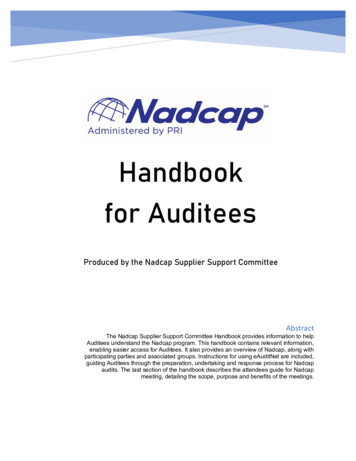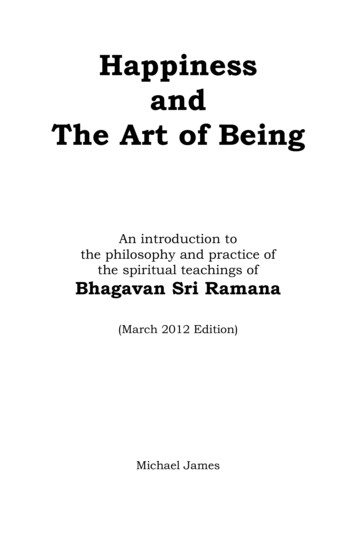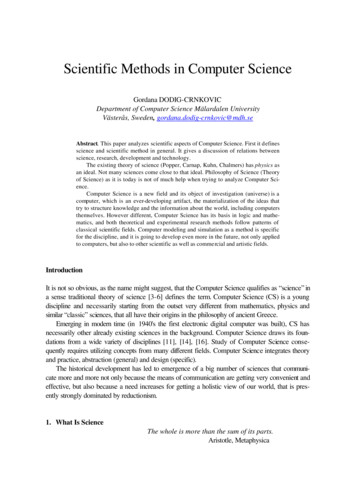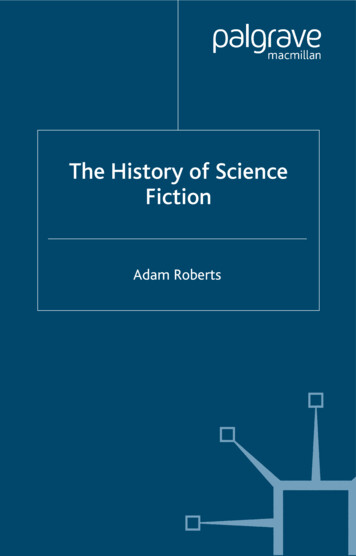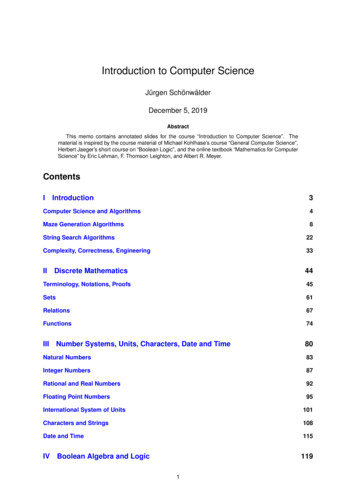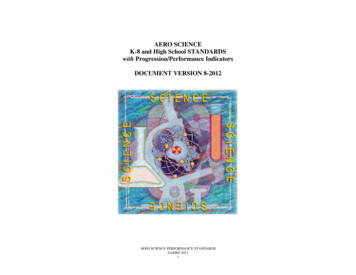
Transcription
AERO SCIENCEK-8 and High School STANDARDSwith Progression/Performance IndicatorsDOCUMENT VERSION 8-2012AERO SCIENCE PERFORMANCE STANDARDS AERO 20111
TABLE OF CONTENTSAERO K-12SCIENCE EDUCATIONFRAMEWORKVision: Science EducationGoals of Science Educ.Progression Indicators345Physical Science (PS)PS.1 Properties of MatterPS.1 (K-8)PS.1 (HS)PS.2 Changes in MatterPS.2 (K-8)PS.2 (HS)PS.3 Forms of EnergyPS.3 (K-8)PS.3 (HS)PS.4 Energy Transfer/ConsPS.4 (K-8)PS.4 (HS)PS.5 Motion at Macro LevelPS.5 (K-8)PS.5 (HS)PS.6 Forces Affecting MotionPS.6 (K-8)PS.6 (HS)78918212224252632343540424344454649Earth & Space Sciences (ESS)ESS.1 Objects in SpaceESS.1 (K-8)ESS.1 (HS)ESS.2 History of EarthESS.2 (K-8)ESS.2 (HS)ESS.3 Prop of Earth’s MaterialsESS.3 (K-8)ESS.3 (HS) ESS.4 Tectonics ESS.4 (K-8) ESS.4 (HS) ESS.5 Energy in Earth SysESS.5 (K-8) ESS.6 Climate and WeatherESS.6 (K-8) ESS.6 (HS) ESS.7 Biogeochemical CyclesESS.7 (K-8) ESS.7 (HS) 515253586061687071767778818283858691929398AERO SCIENCE PERFORMANCE STANDARDS AERO 20112Life Sciences (LS) LS.1 Organization/DevelopmentLS.1 (K-8) LS.1 (HS) LS.2 Energy Transformations .LS.2 (K-8) LS.2 (HS) LS.3 Interdependence LS.3 (K-8) LS.3 (HS) LS.4 Heredity and Reproduction.LS.4 (K-8) LS.4 (HS) LS.5 Evolution and Diversity LS.5 (K-8) . LS.5 (HS) entific Inquiry and Critical ThinkingSkills 128SI.1 (K-8) . 129SI.1 (HS) . 131History and Nature of Science. 132HS.1 (K-8) 133HS.1 (HS)135
A SPECIAL NOTE ABOUT THE NEXT GENERATION SCIENCE STANDARDS (NGSS) AUGUST 2012The NGSS is in production. A public draft was shared in May 2012 and a second draft is due around November 2012. Thedevelopers hope to release the final version in the first quarter of 2013. It will be quite a while before we know many of thedetails of this initiative but we plan to watch the process carefully. For now, the best advice we can offer is that if your schoolis interested in matching to these AERO science standards, you should continue as planned. With the emergence of NGSSwe’ll help you make the “cross-walk” between the current and the new standards.VISION FOR SCIENCE EDUCATIONScience is a way of making sense of the natural world. Scientists seek to describe its complexity, to explain its systems and events, andto find the patterns that allow for predictions and understandings. Science is the basis for the design of technologies that solve realworld problems. Not all students will become scientists or engineers. But science and technology occupy ever-expanding places in oureveryday lives. As citizens, we are asked to make decisions about social issues that involve science and technology. As workers, wehave occupations that increasingly involve science and technology. In the 21st century, adults will need to be comfortable andcompetent in a complex, scientific and technological world. Schools have the responsibility of preparing students for the future.Schools must prepare all students — regardless of their future aspirations — to be scientifically literate.Therefore, all graduates of a school science program should be: knowledgeable about the important concepts and theories of the three major branches of scientific study: earth, life, andphysical sciences; able to think scientifically and use scientific knowledge to make decisions about real–world problems; able to construct newknowledge for themselves through research, reading, and discussion; familiar with the natural world, and respectful of its unity, diversity, and fragility; able to make informed judgments onstatements and debates claiming to have a scientific basis; and, able to reflect in an informed way on the role of science inhuman affairs.To make this happen, the science curriculum needs to: emphasize understanding, not content coverage;AERO SCIENCE PERFORMANCE STANDARDS AERO 20113
promote learning that is useful and relevant;emphasize scientific literacy for ALL students; and,promote interdisciplinary learning.AERO SCIENCE PERFORMANCE STANDARDS AERO 20114
Goals of Science Education1. Students will use inquiry strategies to investigate and understand the natural world.2. Students will demonstrate an understanding of key concepts and principles central to the life, physical, and earth sciences, andengineering, while recognizing the interrelationship of all the sciences.3. Students will demonstrate an understanding of the basic laws which govern and explain phenomena observed in the natural world4. Students will demonstrate an understanding of, and be able to practice, the basic processes that scientists use to obtain and continuallyrevise knowledge about the natural world.5. Students will perceive that scientific and technological knowledge is the result of the cumulative efforts of people, past and present, whohave attempted to explain the world through an objective, peer-tested, rational approach to understanding natural phenomena andoccurrences.6. Students will display a sense of curiosity and wonder about the natural world, and demonstrate an increasing awareness of theinterdependence between all living things and the environment.7. Students will demonstrate their abilities to identify human needs and concerns and to engage in problem-solving processes to define theproblem, research and generate solutions, and develop simulations and prototypes to test their ideas before implementation.8. Students will be able to apply rational, creative-thinking, and investigative skills and use scientific and technical knowledge in their rolesas citizens, workers, family members, and consumers in an increasingly technological society.9. Students will use oral and written communication, mathematical representation, and physical and conceptual models to describe andexplain scientific concepts and ideas, and will be able to apply scientific and technical knowledge.10. Students will know and employ safe practices and techniques in the laboratory, in fieldwork or any other scientific investigation, and whenusing scientific or technological materials at home or work.AERO SCIENCE PERFORMANCE STANDARDS AERO 20115
Performance IndicatorsThe diagram below illustrates how content and practices are combined (“crossed”) to generate the performance indicators. Thecolumns contain the science content (defined by content statements in three broad areas), and the rows contain the four sciencepractices. The cells at the intersection of content (columns) and practices (rows) contain student performance indicators. The contentand practice categories are not distinct; and therefore, some overlap in the resultant performance indicators is to be expected. (NAEP2009)Science PracticesSCIENCE CONTENTEARTH AND SPACESCIENCE(Content statements)PHYSICAL SCIENCE(Content statements)LIFE SCIENCE(Content statements)Identifying ndicatorsPerformanceIndicatorsUsing ceIndicatorsPerformanceIndicatorsUsing ndicatorsPerformanceIndicatorsUsing eIndicatorsPerformanceIndicatorsAERO SCIENCE PERFORMANCE STANDARDS AERO 20116
Communicate accurately and effectivelyProgression of General Performance Indicators for Science PracticesIdentifyingScientificPrinciplesUsing SciencePrinciplesUsing ScientificInquiryUsingTechnologicalDesignDescribe, measure,or classifyobservationsState or recognizecorrect scienceprinciplesExplainobservationsof phenomenaPredictobservationsof phenomenaDesign and critiqueaspects of scientificinvestigationsConduct scientificinvestigationsusing appropriatetools andtechniquesPropose or critiquesolutions toproblems givencriteria andscientificconstraintsIdentify scientifictradeoffs in designdecisions andchoose mong closelyrelated scienceprinciplesDemonstraterelationships amongdifferentrepresentations ofprinciplesSuggest examplesof observations thatillustrate a scienceprinciplePropose, analyze,and evaluatealternativeexplanations orpredictionsIidentify patterns indata and/or relatepatterns in data totheoretical modelsUse empiricalevidence to validateor criticizeconclusions aboutexplanations andpredictionsApply scienceprinciples or datato anticipate effectsof technologicaldesign decisionsNA2009 NAEP FRAMEWORKAERO SCIENCE PERFORMANCE STANDARDS AERO 20117
PHYSICAL SCIENCEPhysical science principles, including fundamental ideas about matter, energy, and motion, are powerful conceptual tools for making senseof phenomena in physical, living, and Earth systems. Familiar changes—an ice cube melting, a baseball changing direction after beingstruck by a bat, the appearance of a bolt of lightning, the formation and erosion of mountains, and the growth of a plant—can be explainedusing these fundamental ideas.Energy is the constant in an ever-changing world. Energy from the sun fuels electrical storms, hurricanes, tornados, and photosynthesis. Inturn, the products of photosynthesis (carbohydrates and oxygen) react during respiration to fuel the life processes, such as growth andreproduction, of plants and animals. Consequently, it is important for students to develop an understanding of physical science principlesearly and to appreciate their usefulness across Physical Science, Life Science, and Earth and Space Science. (NAEP, 2009 Framework)AERO SCIENCE PERFORMANCE STANDARDS AERO 20118
PHYSICAL SCIENCESTANDARDS and PERFORMANCE INDICATORSStandardPS: Physical ScienceStudents will develop an understanding of the concepts, models, theories, universal principles, and facts that explain the physical world.StrandStandardPS.1 Properties of MatterStudents will develop an understanding of the characteristic properties of matter and the relationship of these properties to their structure lQuestionProperties of MatterEveryone has experience with matter in a variety of forms. Such experiences help build students’ understanding of similarities and differences inthe properties of matter. Their personal experiences help students understand common properties such as hardness, strength, color, shape, andstates of matter (solid, liquid, and gaseous). Knowledge of observable properties of matter and its structure and composition is helpful inconsidering matter’s varied uses, availability, and limitations in our world.All living and nonliving things are composed of matter having characteristic properties that distinguish one substance from another (independent ofsize/amount of substance).How do the properties of materials determine their use?AERO SCIENCE PERFORMANCE STANDARDS AERO 20119
BenchmarksDescribing MatterComposition of MatterProgressionLevelsPS.1.4A: By the end of Grade 4, students will be able to collect and organizedata about physical properties in order to classify objects or draw conclusionsabout objects and their characteristic properties (e.g., temperature, color, size,shape, weight, texture, flexibility).12345Identify thematerials thatmake up anobject. (e.g.,desk is madeup of wood andmetal, bike ismade up ofmetal, rubber,and plastic)Describeobjects interms of whatthey aremade of andtheir physicalpropertiesCompare,sort andgroup objectsin terms ofwhat they aremade of(e.g., clay,cloth, paper,or metal)Describefeatures ofthe object ormaterial thatare onlyvisible withthe use of themagnifier.Usemeasures ofweight (data)todemonstratethat thewhole equalsthe sum of itsparts.AERO SCIENCE PERFORMANCE STANDARDS AERO 201110PS.1.8A: By the end of Grade 8, students when given graphicor written information will be able to classify matter asatom/molecule or element/compound (Not the structure of anatom).6789Explain thatall matter iscomposed ofminuteparticlescalled atoms;and explainthat allsubstancesare composedof atoms,eacharranged intodifferentgroupingsIdentifyelements assubstancesthat containonly one kindof atom andexplain thatelements donot breakdown bynormallaboratoryreactions,such asheating,exposure toelectriccurrent, andreaction toacid.Use modelsor diagramsto show thedifferencebetweenatoms andmolecules.Givengraphic orwritteninformation,classifymatter as anatom /molecule orelement/compound(not thestructure ofan atom).
PS.1.4B: Not addressed at this levelBenchmark12345Explain thatover onehundredelementsexist, andidentify theperiodic tableas a tool fororganizingtheinformationabout them.Periodic TableComposition of MatterProgressionLevelsPS.1.8B: By the end of Grade 8, students will explain howproperties of elements and the location of elements on theperiodic table are related.6789AERO SCIENCE PERFORMANCE STANDARDS AERO 201111Explain thatelements areorganized inthe periodictableaccording totheirproperties.Use theperiodic tableto obtaininformationabout a givenelement.Predict howan atom'selectronarrangementinfluences itsability totransfer orshareelectrons andis related itsposition onthe periodictable.
12345Describehowelements cancombine toform newsubstancesthat oftenhavedifferentproperties.CompoundsComposition of MatterProgressionLevelsPS.1.8B: By the end of Grade 8, students will explain howproperties of elements and the location of elements on theperiodic table are related.6789AERO SCIENCE PERFORMANCE STANDARDS AERO 201112Demonstratewith atomicmodels (e.g.,ball andstick) howatoms cancombine in alarge numberof ways toform amolecule orformula unit(crystal).Use data toinfer orpredict thatthe totalamount ofmass in aclosedsystem staysthe same,regardless ofhowsubstancesinteract(conservationof matter).
12345Differentiatebetween amixture and apuresubstance.MixturesComposition of MatterProgressionLevelsPS.1.8B: By the end of Grade 8, students will explain howproperties of elements and the location of elements on theperiodic table are related.6789AERO SCIENCE PERFORMANCE STANDARDS AERO 201113Describe thedifferentatoms andmolecules inmixtures(e.g.,dissolvingcarbondioxide inwaterproduces atype ofmixture[solution] ofCO2 and H20molecules).Demonstratehow mixturescan beseparated byusing theproperties ofthesubstancesfrom whichthey aremade, suchas particlesize, density,solubility andboiling point.
BenchmarkDescribing MatterProperties of MatterProgressionLevel sPS.1.4C: By the end of Grade 4, students will be able to identify and describe thephysical and chemical properties of a substance.12345Identify theobservableproperties ofdifferentobjects, such ascolor, size,shape, weightand texture.Useattributes ofproperties tostate whyobjects aregroupedtogether(e.g., thingsthat roll,things thatare rough).Identify,compare, andsort objectsby similar ordifferentphysicalproperties(e.g., size,shape, color,texture,smell,weight).Identify,compare, andsort objectsby similar ordifferentphysicalproperties(e.g., size,shape, ,odor,elasticity,length, mass,area, volume,perimeter).Collect andorganize dataaboutphysicalproperties inorder toclassifyobjects ordrawconclusionsabout objectsand or, size,shape,weight,texture,flexibility).AERO SCIENCE PERFORMANCE STANDARDS AERO 201114PS.1.8C: By the end of Grade 8, students will be able to usephysical and chemical properties as determined through aninvestigation to identify a substance.6789Identifysubstances bytheir physicaland chemicalproperties,such g andmeltingpoints.Identifyelementsaccording totheircommonproperties,such ashighlyreactivemetals, lessreactivemetals,highlyreactive nonmetals andalmost nonreactivegases.Separatesubstancesbased ontheir physicalproperties(e.g., ,malleability,solubility,ductility,boiling point,freezingpoint,conductivity,flammability)and identify amolecule asthe smallestpart of asubstancethat retainsits properties.Given dataaboutcharacteristicproperties ofmatter (e.g.,melting andboilingpoints,density,solubility,acid or base),identify,compare, orclassifydifferentsubstances.
BenchmarkProgressionLevelsPS.1.4D: By the end of Grade 4, Students will make a prediction about whatmight happen to the state of common materials when heated or cooled andcategorize materials as a solid, liquid, or gas12345States of MatterProperties of MatterIdentifymatter thatcan be aliquid or solid(e.g., water).Identify andcomparesolids (e.g.have adefiniteshape) andliquids (e.g.take the shapeof theircontainers).Investigateand recognizewater canchange from aliquid to asolid (freeze),and back againto a liquid(melt), as theresult oftemperaturechanges.Compare theobservablephysicalproperties ofsolids,liquids, orgases (air)(i.e., visiblevs. invisible,changes inshape,changes inthe amountof spaceoccupied).Make apredictionabout whatmight happento the state ofcommonmaterialswhen heatedor cooled; orcategorizematerials assolid, liquid,or gas.AERO SCIENCE PERFORMANCE STANDARDS AERO 201115PS.1.8D: By the end of Grade 8, students will represent orexplain the relationship between or among energy, molecularmotion, temperature, and states of matter.6789Predict theeffect ofthermalenergy on thephysicalproperties ofwater as itchanges toand from asolid, liquid,or gas reatediagrams ormodels thatrepresent thestates ofmatter at themolecularlevel.Explain theeffect ofincreased anddecreasedthermalenergy on themotion andarrangementof molecules.Observe thephysicalprocesses ofevaporationandcondensation, or freezingand melting,and describethesechanges interms ofmolecularmotion andconservationof mass.
12345Predict thechanges inthe state ofmatter whenadding ortaking awayheat (e.g., icemelting,water boilingor freezing,condensation/evaporation).Changes of StateProperties of MatterProperties in MatterProgressionLevelsPS.1.8D: By the end of Grade 8, students will represent orexplain the relationship between or among energy, molecularmotion, temperature, and states of matter.6789AERO SCIENCE PERFORMANCE STANDARDS AERO 201116Describe howmatterchanges fromone phase toanother (e.g.,condensation,evaporation).Describe themovement ofindividualparticles andverify theconservationof matterduring thephasechanges (e.g.,melting,boiling,or freezing).Explain thatstates ofmatterdepend onthearrangementof themoleculesand theirmotion.
BenchmarkMeasuring MatterProperties of MatterProgressionLevelsPS.1.4E: By the end of Grade 4, Students will use measures of weight (data) todemonstrate that the whole equals the sum of its parts.12345Use nonstandard unitsof measure(e.g., string,paper clips)to comparethe size andweight ofnon-livingmaterials.Use simpletools (e.g.balance scale,see-saw) toexplore theproperty ofweight.Use standardtools tomeasureobjects ormaterials (e.g.,ruler, meterstick,measuringtape, panbalance,thermometer,graduatedcylinder).Select theappropriatemetricsystem toolsformeasuringlength,width,temperature,volume, andmass.Show that theweight of anobjectremains thesame despitea change inits shape.AERO SCIENCE PERFORMANCE STANDARDS AERO 201117PS.1.8E: By the end of Grade 8, students will be able toinvestigate and explain the relationships among mass, volumeand density.6789Demonstratethatregardless ofhow parts ofan object arearranged, themass of thewhole isalways thesame as thesum of themasses of itsparts.Differentiatebetweenweight andmass.Explain howdifferentsubstances ofequal volumeusually havedifferentweights.Differentiatebetweenvolume andmass andcalculate thedensity oflarge andsmallquantities ofa variety ofsubstances(e.g.,aluminumfoil, water,copper, clay,rock).
BenchmarkMagnetic PropertiesProperties of MatterProgressionLevelsPS.1.4F: By the end of Grade 4, Students will use observations of magnets inrelation to other objects to describe the properties of magnetism (i.e., attract orrepel certain objects or has no effect)12345Observe andsort objectsthat are andare notattracted tomagnets.Predictwhether ornot an objectwill beattracted to amagnet.Describe whathappens whenlike andopposite polesof a magnetare placednear eachother.Describe thephysicalproperties ofmagnets.Determinethe relativestrength ofvariousmagnets (e.g.size, numberof paper clipsattracted,etc.)AERO SCIENCE PERFORMANCE STANDARDS AERO 201118PS.1. 8F: Not Addressed at this level6789
Benchmarks PS.1.4A: By the endof Grade 4, studentswill be able to collectand organize dataabout physicalproperties in order toclassify objects ordraw conclusion aboutobjects and theircharacteristicproperties (e.g.temperature, color,size, shape, weight,texture, flexibility).PS.1.8A: By the endof Grade 8, studentswhen given graphic orwritten informationwill be able to classifymatter asatom/molecule orelement/compound(not the structure of anatom).PS.1.12A: By the end of Grade 12, students will be able connect the arrangement of, and thestrength of interactive forces between, atoms or molecules to the physical properties of solids,liquids, and gases.1Explain how weknow that atomsexist?2Relate the kineticmolecular theory tothe properties of anideal gas.AERO SCIENCE PERFORMANCE STANDARDS AERO 2011193Relate verbally,mathematically, orgraphically thebehavior of theparameters thatdescribe the physicalbehavior of gases.4List the conditionsunder which gasesdeviate from idealbehavior.5Interpret a phasediagram.
Benchmarks Benchmarks PS.1.4B: Notaddressed at this level.PS.1.8B: By the end ofGrade 8, students willexplain how propertiesof elements and thelocation of elementson the Periodic Tableare related.ANDANDPS.1.4C: By the endof Grade 4, studentswill be able to identifyand describe thephysical and chemicalproperties of asubstance.PS.1.8C: By the endof Grade 8, studentswill be able to usephysical and chemicalproperties asdetermined through aninvestigation toidentify a substance.PS.1.4D: By the endof Grade 4, studentswill make a predictionabout what mighthappen to the state ofcommon materialswhen heated or cooledand categorizematerials as a solid,liquid, or gas.PS.1.8D: By the endof Grade 8, studentswill represent orexplain therelationship betweenor among energy,molecular motion,temperature, and statesof matter.PS.1.12B: By the end of Grade 12, students understand the commonality and patterns of physicaland chemical properties through the arrangement of atomic number within the Periodic Table.123Describe theevidence for theexistence of electronsand protons and theirpresence in atoms.Relate the propertiesof the main-groupelements to theirelectronarrangements.Explain why metalsare good conductorsof electricity andheat.45Relate trends in theperiodic table to theatomic structures ofelements.PS.1.12D: Not addressed at this level12AERO SCIENCE PERFORMANCE STANDARDS AERO 201120345
Benchmarks Benchmarks Benchmarks PS.1.4E: By the end ofGrade 4, students willuse measures ofweight (data) todemonstrate that thewhole equals the sumof its parts.PS.1.8E: By the end ofGrade 8, students willbe able to investigateand explain therelationships amongmass, volume anddensity.PS.1.12E: Not addressed at this levelPS.1.4F: By the end ofGrade 4, students willuse observations ofmagnets in relation toother objects todescribe the propertiesof magnetism (i.e.,attract or repel certainobjects or has noeffect).PS.1.4F: Notaddressed at this level.PS.1.12F: Not addressed at this level PS.1.4G: Notaddressed at thislevel.11PS.1.4G: Not addressedat this level.22345345PS.1.12G: By the end of Grade 12, students will understand the composition of atoms andtheir characteristics (mass, charge, and electric/nuclear forces) and know that a neutral atom hasequal numbers of protons and electrons and that isotopes of an element have different numbersof neutrons.1Describe thecomposition ofatom.2Describe the resultsof Thomson,Rutherford, andBohr models of theatomAERO SCIENCE PERFORMANCE STANDARDS AERO 20112134Explain thedifferences betweenelectrical andnuclear forces.Describe how thestrong nuclear forceacts amongnucleons.5Explain what asnuclei get heaviermany becomeradioactive.
StandardStrand nPS: Physical ScienceStudents will develop an understanding of the concepts, models, theories, universal principles, and facts that explain the physical world.PS.2 Changes in MatterStudents will develop an understanding that interactions can produce changes in a system, although the total quantities of matter and energyremain unchanged.Changes in MatterInteractions between matter and energy account for changes observed in everyday events. Understanding how matter and energy interact extendsstudents’ knowledge of the physical world and allows them to monitor and explain a wide variety of changes and to predict future physical andchemical changes. Students gain both a practical and conceptual understanding of the laws of conservation of matter and energy.Energy is necessary for change to occur in matter.How does conservation of mass apply to the interaction of materials in a closed system?AERO SCIENCE PERFORMANCE STANDARDS AERO 201122
BenchmarkPhysical and Chemical ChangesChanges in MatterProgressionLevelsPS.2.4A: By the end of Grade 4, students will differentiate between physicaland chemical changes.123Describe howthe propertiesof certainmaterials canchange whenspecificactions areapplied tothem, such asfreezing,mixing,heating,cutting,dissolving andbending.Demonstratethat whensomesubstancescombine,they mayretain theirindividualproperties(e.g. salt andpepper)and that somemay losetheirindividualproperties(e.g.powdereddrink inwater).4Investigateand explainthat not allmaterialsreact thesame waywhen anaction isapplied tothem.PS.2.8A: By the end of Grade 8, students will demonstrate howsubstances can chemically react with each other to form newsubstances having properties different from those of the originalsubstances.56Differentiatebetween aphysicalchange, suchas melting,and achemicalchange, suchas rusting.Describe howenergy has theability tocreate change.AERO SCIENCE PERFORMANCE STANDARDS AERO 2011237Explain thatoxidationinvolvescombiningoxygen withanothersubstance, asin burning orrusting.89Identifycharacteristicsof chemicalchanges: (e.g.burning,production ofa newsubstance,production oflight, tivity).Demonstratehowsubstancescan reactchemicallywith othersubstances toform newsubstances,known ascompounds,and that insuch recombinationsthe propertiesof the newsubstancesmay be verydifferent fromthose of theold.
12345Identify thereactantsand/orproducts in achemicalreaction.Chemical ReactionsChanges in MatterProgressionLevelsPS.2.8A: By the end of Grade 8, students will demonstrate howsubstances can chemically react with each other to form newsubstances having properties different from those of the originalsubstances.6789AERO SCIENCE PERFORMANCE STANDARDS AERO 201124Classifychemicalreactions byenergy type (e.g.,endothermicandexothermic).Identifyfactors thataffect reactionrates, such astemperature,concentrationand surfacearea, andexplain thatdissolvingsubstances inliquids oftenacceleratesreaction rates.Determine theeffect ofvarious factorson reactionrate (e.g.,temperature,surface area,concentration,agitation).
Benchmarks Benchmarks Benchmarks PS.2.4A: By the end ofGrade 4, students willdifferentiate betweenphysical and chemicalchanges.PS.2.4A: By the endof Grade 4, studentswill differentiatebetween physical andchemical changes.PS.2.4A: By the end ofGrade 4, students willdifferentiate betweenphysical and chemicalchanges.PS.2.8A: By the endof Grade 8, studentswill demonstrate howsubstances canchemically react witheach other to form newsubstances havingproperties differentfrom those of theoriginal substances.PS.2.12A: By the end of Grade 12, students will understand how an atom’s electronic configuration,particularly its outermost electrons determine how the atom interacts with other atoms.PS.2.8A: By the end ofGrade 8, students willdemonstrate howsubstances canchemically react witheach other to form newsubstances havingproperties differentfrom those of theoriginal substances.PS.2.12A: By the end of Grade 12, students will know that changes in state require a transfer ofenergy.PS.2.8A: By the end ofGrade 8, students willdemonstrate howsubstances canchemically react witheach other to form newsubstances havingproperties differentfrom those of theoriginal substances.PS.2.12A: By the end of Grade 12, students understand that reactions are a result of interactionsbetween atoms, molecules or ions.12Explain interactionsbetween atoms thathold them together inmolecules or betweenoppositely chargedions are calledchemical bondsExplain how theconfiguration of atomsdetermine themolecularcombinations.1List evidence thatsuggest a chemicalreaction might haveoccurred and evidencethat proves a chemicalreaction has occurred.1Describe the transferof electrons(oxidation/reduction.2Describe therearrangements ofatoms involvedchemical reactions.2Describe the transferof hydrogen ions inacid/base reactions.AERO SCIENCE PERFORMANCE STANDARDS AERO 2011253434Explain how nonspontaneous reactionscan occur.Distinguish betweenexothermic andendothermic reactions.34Describe how bondsare created by sharingelectrons.Explain the origins ofsynthetic polymers,oils, and the largemolecules essential tolife.555
sentialQuestion?PS: Physical ScienceStudents will develop an understanding of the concepts, models, theories, universal principles, and facts that explain the physical world.PS.3 Forms of EnergyStudents will develop an understanding of the characteristics of energy and the interactions between matter and energy.Forms of EnergyEnergy is a central concept in science because all physical interactions involve changes in energy. Students need to understand that all physicalevents involve transferring energy or changing one
SCIENCE EDUCATION FRAMEWORK Vision: Science Education 3 Goals of Science Educ. 4 Progression Indicators 5 Physical Science (PS) 7 PS.1 Properties of Matter 8 PS.1 (K-8) 9 PS.1 (HS) 18 PS.2 Changes in Mat
